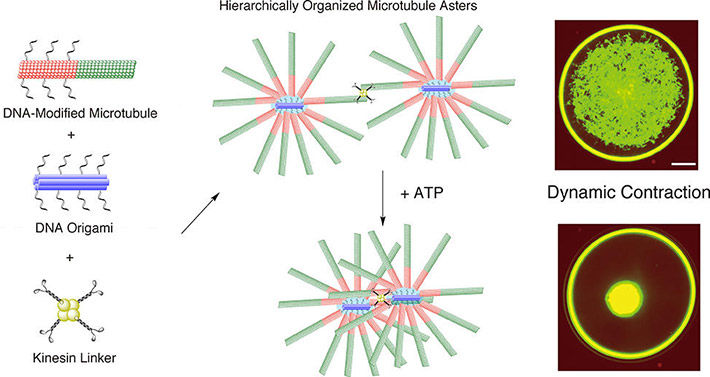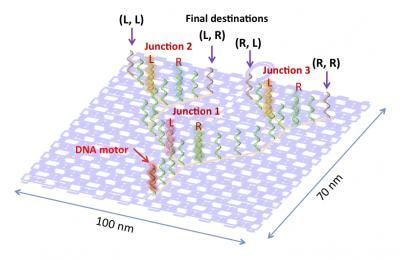DNA origami to scale-up molecular motors
Researchers have successfully used DNA origami to make smooth-muscle-like contractions in large networks of molecular motor systems, a discovery which could be applied in molecular robotics.

Mixing DNA-modified microtubules, DNA origami and kinesin linkers leads to star-like formations of microtubules that are connected by kinesin linkers. This network contracted dynamically when ATP energy was added.
Matsuda K. et al., Nano Letters, April 30, 2019
"We successfully demonstrated programmed self-assembly of a biomolecular motor system," write the researchers from Japan and Germany who conducted the study.
The biomolecular motor system, consisting of fibrous microtubules and motor protein kinesins, plays an essential role in cellular transportation systems. Scientists believe they can utilize the motors in molecular robotics but it remains difficult to assemble a larger system from the tiny molecules.
In the current study published in Nano Letters, the research team including Akira Kakugo of Hokkaido University, Akinori Kuzuya of Kansai University, and Akihiko Konagaya of Tokyo Institute of Technology developed a system combining DNA origami and microtubules. The DNA origami were formed from six DNA helices bundled together. Mixing the two components caused the microtubules to self-assemble around the DNA origami forming star-shaped structures. This self-assembly was made possible by the binding of complementary DNA strands attached to each component.
The team then designed a "kinesin linker" which is made of four kinesin motor proteins radiating from a central core protein. These kinesin linkers joined the microtubules together, causing multiple star-like assemblies to connect, forming a much larger hierarchical network.
When adenosine triphosphate (ATP), a molecule which stores and carries energy, was added to the system, the kinesin linkers moved, causing the microtubular network to dynamically contract within a matter of minutes. This resembled the contraction of smooth muscles according to the researchers.
This dynamic contraction only happened when the DNA origami were present, suggesting the importance of the hierarchical assembly within the microtubular network. "Further studies could lead to the use of DNA for controlled, programmable self-assembly and contraction of biomolecular motors. Such motors could find applications in molecular robotics and the development of microvalves for microfluidic devices," says Akira Kakugo.
Original publication
Most read news
Original publication
Kento Matsuda et al.; "Artificial Smooth Muscle Model Composed of Hierarchically Ordered Microtubule Asters Mediated by DNA Origami Nanostructures"; Nano Letters
Organizations
Other news from the department science

Get the life science industry in your inbox
By submitting this form you agree that LUMITOS AG will send you the newsletter(s) selected above by email. Your data will not be passed on to third parties. Your data will be stored and processed in accordance with our data protection regulations. LUMITOS may contact you by email for the purpose of advertising or market and opinion surveys. You can revoke your consent at any time without giving reasons to LUMITOS AG, Ernst-Augustin-Str. 2, 12489 Berlin, Germany or by e-mail at revoke@lumitos.com with effect for the future. In addition, each email contains a link to unsubscribe from the corresponding newsletter.





















































